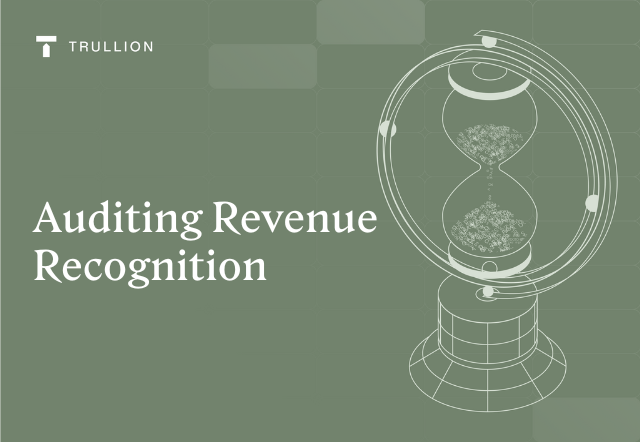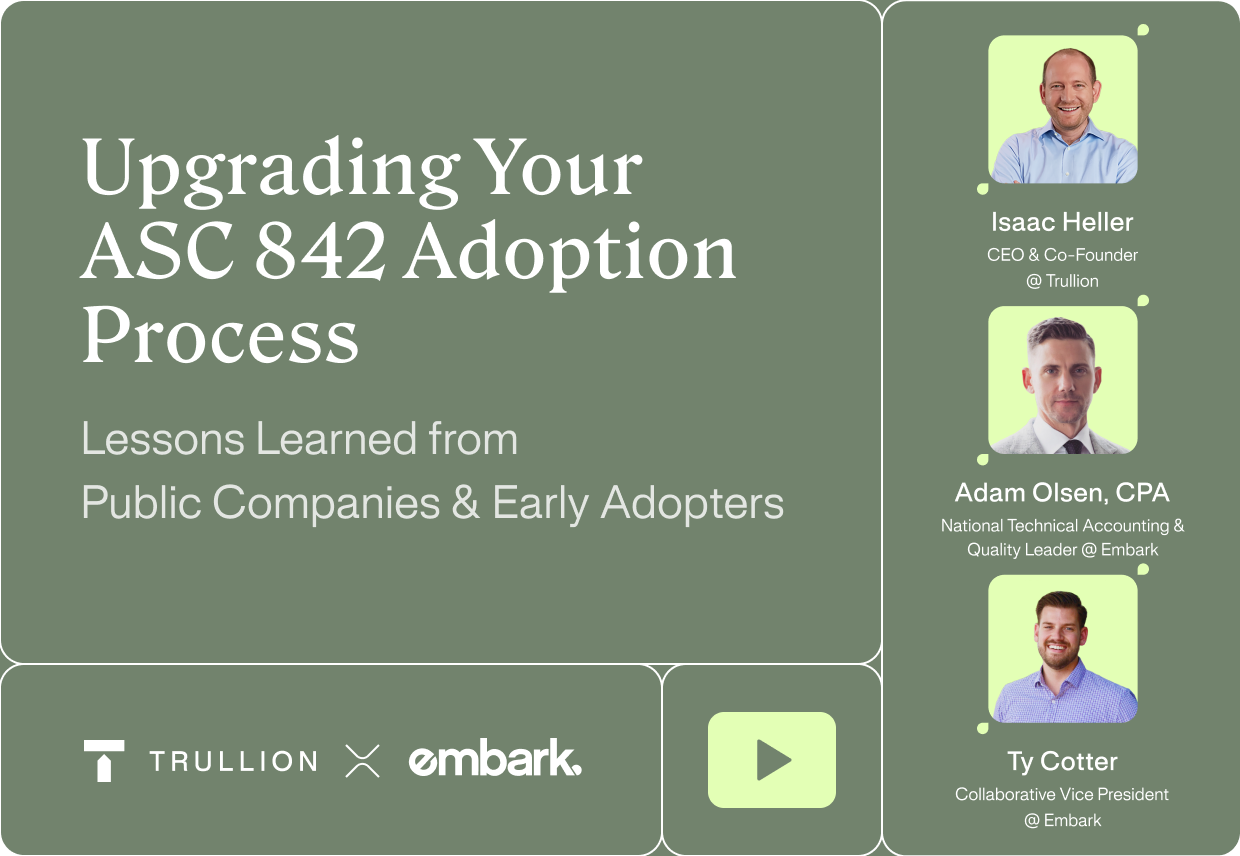Prepare For Enhanced Revenue Audit Procedures
Revenue is consistently one of the key areas that auditors focus on when it comes to audit procedures, being highly topical given recently updated revenue standards. This makes it critical to gain an overall understanding of audit and revenue recognition within your organization.
Understanding Revenue Recognition
Revenue recognition is a fundamental principle in accounting, that refers to the process of determining and recording revenue when it is earned.
In recent years, revenue recognition has undergone significant changes due to the adoption of new revenue recognition standards, such as ASC 606 (Revenue from Contracts with Customers) and IFRS 15 (Revenue from Contracts with Customers).
As IFRS 15 puts it, for example, “The objective of this Standard is to establish the principles that an entity shall apply to report useful information to users of financial statements about the nature, amount, timing and uncertainty of revenue and cash flows arising from a contract with a customer.”
These standards introduce a more principles-based approach, emphasizing the recognition of revenue when control of goods or services is transferred to customers, rather than when the risks and rewards of ownership are transferred. The objective is to provide more transparency and consistency in financial reporting and enable users of financial statements to make better-informed decisions.
These changes have necessitated adjustments to accounting practices and systems, leading to increased scrutiny and compliance efforts in revenue recognition processes.
The key principles and criteria for revenue recognition, as outlined in both ASC 606 and IFRS 15, share common elements – while also having some differences. The core principles and criteria are as follows:
- Identification of a contract: both standards require the presence of a contract between a company and a customer as a prerequisite for revenue recognition. The contract should be enforceable and specify the rights and obligations of both parties.
- Performance obligations: revenue is recognized when a company satisfies a performance obligation by transferring control of goods or services to the customer. A performance obligation is essentially a promise to deliver a distinct product or service.
- Determination of transaction price: the transaction price is the amount of consideration a company expects to receive in exchange for transferring goods or services to the customer. It may be subject to adjustments for discounts, rebates, variable consideration, or the time value of money.
- Allocation of transaction price: if a contract includes multiple performance obligations, the transaction price is allocated to each obligation based on their standalone selling prices (SSP). This allocation should reflect the amount the company expects to receive for satisfying each obligation.
- Recognize revenue when each performance obligation is satisfied: this could be at a specific point in time, or over time.
The differences between ASC 606 and IFRS 15 lie in the details and terminology used to implement these principles:
- ASC 606 places more emphasis on specific guidance for certain industries, such as software, construction, and telecommunications. It also provides more comprehensive guidance on topics like variable consideration, contract costs, and accounting for warranties.
- IFRS 15 includes additional guidance on contract modifications, the treatment of contract costs, and specific criteria for recognizing revenue over time.
Despite these differences, the overarching goal of both standards is to provide a principles-based approach to revenue recognition that focuses on the transfer of control and consistency in financial reporting.
Given this background, the next question is: how to audit revenue recognition.
Auditing Revenue Recognition: Overview
Purpose of auditing revenue
Revenue is a significant component of financial performance (in many cases the most significant), and errors or anomalies in its recognition can have a substantial impact on the financial statements of a company, and by extension the decisions made by various stakeholders and users of those financial statements.
Because of this, auditors must assess the risk of fraud, address the complexity of revenue recognition, and provide stakeholders with confidence in the reliability of financial information. Through their audit procedures for revenue, auditors safeguard against misrepresentation, maintain integrity in financial reporting, and help stakeholders make informed decisions.
An in-depth audit of revenue provides independent assurance and verification of the accuracy and reliability of a company’s revenue recognition processes and financial statements. Auditing revenue involves examining the underlying transactions, contracts, and supporting documentation to assess whether the revenue has been recognized in accordance with the applicable accounting standards and the company’s internal policies.
Importance of independent verification and assurance
An independent audit enhances the credibility and reliability of financial statements by providing an unbiased and objective evaluation of revenue recognition processes. Independent auditors, with their expertise and professional standards, offer an external perspective, reducing the potential for management bias or manipulation.
Such an audit also instills confidence in stakeholders, including investors, lenders, and regulators, who rely on audited financial statements for their decision-making.
The independent verification of revenue ensures that the reported figures are accurate, complete, and in compliance with applicable accounting standards and regulations.
Finally, the audit acts as a deterrent against fraudulent activities, as auditors actively assess the risk of revenue-related fraud and employ robust audit procedures to detect and prevent misstatements.
Challenges and complexities in auditing revenue recognition
Revenue is often a high-risk section for auditors. Auditing revenue and designing the right audit procedures presents unique challenges:
- Subjectivity and judgment: revenue recognition often involves subjective assessments and professional judgment, especially in determining the timing and amount of revenue recognition.
- Complex revenue models: certain industries, such as software, construction, and telecommunications, have complex revenue models due to long-term contracts, multiple performance obligations, and variable considerations.
- IT Systems and data integrity: auditing revenue often relies on information technology (IT) systems and data integrity. Auditors must evaluate the effectiveness and reliability of internal controls over revenue recognition, including the accuracy and completeness of data inputs.
- Sampling and testing: due to the volume and diversity of revenue transactions, auditors typically rely on sampling methods to test the completeness and accuracy of revenue recognition.
- Contract modifications: changes or modifications to contracts can impact revenue recognition. Auditors need to evaluate the accounting treatment of contract modifications, including whether they represent separate contracts or modifications to existing contracts.
- New revenue recognition standard: the adoption of a new revenue recognition standard, such as ASC 606 and IFRS 15, has introduced significant changes and complexities. Auditors must assess the company’s transition process, including the implementation of new policies, systems, and internal controls. They need to ensure that the company has properly applied the new standards and made appropriate disclosures in the financial statements.
Establishing a Comprehensive Audit Plan
An effective audit, including audit procedures for revenue, has to be planned properly. To establish an effective audit plan, the following key elements must be incorporated.
Identification of revenue recognition risks
The identification of revenue recognition risks is a crucial component of the audit plan. Auditors must carefully assess the company’s revenue recognition processes, systems, and controls to identify potential risks that may result in material misstatements or fraudulent activities.
More specifically, the main audit risks associated with revenue recognition include:
- Completeness: the risk that all revenue transactions and related performance obligations have been appropriately recorded and recognized in the financial statements.
- Accuracy: the risk that revenue recognition is not accurate, resulting in misstatements in the reported revenue figures.
- Cut-off: the risk that revenue transactions are not recorded in the correct accounting period.
- Valuation: the risk that the value assigned to revenue is not reasonable or properly supported.
- Existence and occurrence: the risk that recorded revenue may not correspond to actual transactions or that the revenue has not been earned in accordance with the applicable criteria.
- Presentation and disclosure: the possibility that revenue-related information is not presented or disclosed accurately or in accordance with the relevant accounting standards.
- Fraud and misrepresentation: the risk of intentional manipulation or fraudulent activities related to revenue recognition.
Determining materiality and significant accounts
When it comes to materiality and significant accounts, auditors should use their judgment. Items to consider include:
- The financial reporting framework being used: for example. Generally Accepted Accounting Principles (GAAP), or International Financial Reporting Standards (IFRS)
- Assessing the users’ perspective, including their needs and expectations
- Quantitative factors, such as the magnitude of revenue reported in the financial statements, the proportion of revenue to total assets, equity, or income, and the significance of revenue trends or changes over time
- Qualitative factors include the nature of the industry, contractual obligations, and the company’s overall financial condition.
- Legal and regulatory requirements
Once these factors are taken into account, a tailored audit approach can be embarked upon, with the correct audit procedures in place.
Audit Procedures for Revenue Recognition
The audit procedures for revenue will flow from the audit plan discussed in the previous section. Overall, such testing includes:
Testing the effectiveness of internal controls
These audit procedures involve assessing the effectiveness and reliability of the company’s processes designed to ensure accurate and compliant revenue recognition. It includes evaluating controls over contract review, approval, and documentation, assessing the segregation of duties, examining controls related to revenue cutoff and allocation, and reviewing procedures for revenue reconciliations and disclosures.
Revenue recognition: tests of detail
Tests of detail for revenue recognition involve specific audit procedures performed to obtain detailed information and evidence regarding the accuracy and completeness of revenue transactions. These procedures focus on verifying the underlying documentation, assessing compliance with revenue recognition criteria, and ensuring the proper recording and disclosure of revenue in the financial statements.
The tests of detail for revenue recognition can include reviewing sales contracts to assess their completeness and accuracy; or examining supporting documentation such as invoices, delivery records, and customer orders to verify the occurrence and completeness of revenue transactions.
Auditors often perform reconciliations between recorded revenue and the underlying supporting documentation to ensure consistency and accuracy, as well as testing the recognition of various types of revenue: such as product sales, service revenue, or contract modifications.
Substantive testing for revenue recognition accuracy
This involves performing audit procedures to directly assess the accuracy of revenue figures reported in the financial statements. It could include, for example, an analysis of the reasonableness of revenue amounts – by comparing historical trends, and industry benchmarks, or conducting a financial ratio analysis.
In some cases, substantive testing can include the sampling of revenue transactions for detailed testing, including tracing from source documents to the recorded amounts in the financial statements.
Analytical procedures and data analytics in revenue audits
Incorporating analytics in a revenue audit can play a crucial role in providing auditors with valuable insights and identifying potential risks or anomalies in revenue recognition.
These techniques involve analyzing financial and non-financial data, comparing current and historical trends, assessing relationships between different revenue drivers, and utilizing statistical models and predictive analytics.
By applying analytical audit procedures and data analytics, auditors can gain a deeper understanding of revenue patterns, identify unusual fluctuations or inconsistencies, and target areas for further investigation.
Addressing Specific Revenue Recognition Examples
There are some specific revenue recognition examples that should be considered. These include:
Long-term contracts and percentage-of-completion method
Assessing long-term contracts using the percentage-of-completion method involves a thorough examination of the contract terms, project progress, and estimation methodologies employed by the company.
Auditors assess the completeness and accuracy of the contract terms, ensuring they are appropriately documented and adhered to. They evaluate the company’s procedures for determining the percentage of completion, including the reliability of cost and revenue estimates, progress measurements, and the recognition of variations and change orders.
Auditors will also review the company’s accounting policies, disclosures, and internal controls related to long-term contracts to ensure compliance with applicable accounting standards..
Multiple element arrangements and bundling of products/services
In this type of scenario, it’s important to get a thorough understanding of the contract in question, as well as the allocation of transaction price and the determination of separate performance obligations. Key questions to ask include:
- Can the bundled products or services in the arrangement be considered distinct and separately identifiable?
- What are the company’s accounting policies and procedures for allocating the transaction price to each element, based on their relative standalone selling prices?
- What are the estimates or assumptions made in the allocation process?
Revenue recognition for software, subscriptions, and licenses
For these areas, auditors will examine the accounting policies for recognizing revenue from the likes of software sales, subscription services, and licensing arrangements.
They’ll look at things like the contractual terms (including license terms), service level agreements, and any restrictions or conditions on revenue recognition.
Included in this is checking the allocation of revenue between software licenses, maintenance, and support services, as well as assessing the timing of revenue recognition.
These revenue recognition examples show how complex revenue recognition can become, and why it’s such a focus point for audit teams.
Detecting anomalies in Revenue Recognition Audits
Part of an audit is detecting anomalies, especially in connection with revenue. Of course, sometimes such anomalies are surfacing deeper issues, but in many cases, there is something that can be fixed or corrected going forward – it’s also a great way for auditors to add value during their engagement.
For example, a trend analysis can be performed, comparing current revenue figures with historical data and industry benchmarks to identify significant fluctuations or deviations.
Or, key financial ratios and metrics, such as gross profit margins, revenue growth rates, or customer retention rates, can be investigated to identify unusual patterns or outliers.
Thanks to advances in AI-driven technologies, there are now multiple ways to detect anomalies in revenue recognition audits and rectify them where necessary and/or possible.
Documentation and Reporting
Formulating audit opinions and reporting on revenue recognition
The auditor’s opinion will be based on their assessment of the adequacy and appropriateness of revenue recognition in the financial statements, and it is upon this that they will express their professional judgment.
Auditors determine whether revenue recognition is in accordance with the applicable accounting standards, and the company’s accounting policies. They consider the materiality of any identified misstatements or deviations from the standards, and based on their findings, they then provide an audit opinion in their report, expressing whether the financial statements present a true and fair view – and whether revenue recognition is fairly stated.
The audit report communicates the auditor’s conclusions, provides transparency to stakeholders, and enhances the overall credibility and reliability of the financial statements revenue recognition.
How Trullion Can Help
Trullion is the AI-powered accounting automation platform that’s made for accounting and audit teams to streamline processes, ensure accuracy and compliance, reduce repetitive manual work, and create one source of truth.
Among other solutions, Trullion offers two innovative products that are purpose-built for audit and revenue recognition: Revenue by Trullion, and Audit by Trullion.
Revenue by Trullion
The Revenue model enables accounting teams to confidently set product and pricing strategies with the knowledge that everything they do is compliant with regulations and audit-ready.
Built for ASC 606 and IFRS 15, the solution offers data consolidation, recognition logic, revenue analysis, and audit reporting in one seamless package.
Audit by Trullion
Audit teams can now smoothly collaborate with all relevant stakeholders in one platform: a platform that provides audit workflow tools, and client data access, and includes multi-client management.
The solution enables audit teams to easily complete their testing including a dedicated Tests of Detail module, analyze data easily, trace all data back to source documentation, add value, and build trust.
Audit Procedures and Revenue Recognition: Key Takeaways
Revenue is always going to be under the microscope for auditors, and with key revenue standards having changed recently, it’s even more important than ever to ensure that this part of the audit flows smoothly.
For both companies being audited, and auditors themselves, integrating Trullion into this process can be a game-changer in terms of resources required, efficiency, value-add, and communication.
To learn more about Trullion and how it’s used by companies and auditors to drive better results, set up a call with an expert here.










